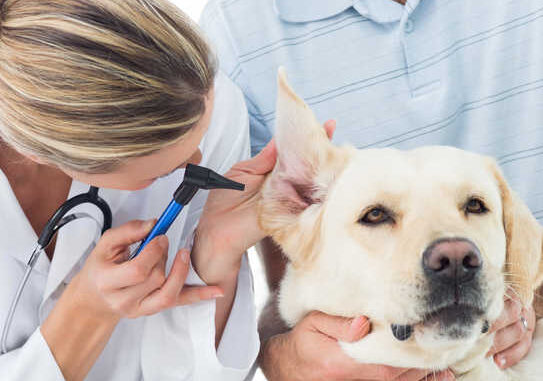
This article was updated on April 29th, 2023
In my practice, we see dogs with ear hematomas at least once a month or more. It is incredibly rare for a hematoma to pop, although the earflap is so puffy and filled with blood that it often seems like it could burst at any second. Ear hematomas can be pretty painful when they get to this point, so it’s best to have your dog treated by your veterinarian.
If the hematoma does pop, here are some things you need to know.
How Do You Know if Your Dog Ear Hematoma Popped?
- A sudden decrease in swelling of the earflap
- Bleeding or draining of blood and serum from the ruptured skin
- Bleeding when your dog shakes his head
My Dog’s Ear Hematoma Popped. Is this Serious?
It is unusual for an ear hematoma to pop, but it occasionally happens. Your dog probably felt some immediate relief – the pressure from the fluid build-up has been removed, and the blood can drain. Since two-thirds of hematoma cases have an underlying cause like an ear infection or ear mites, your dog may still be uncomfortable.
Your veterinarian should still see your dog if the hematoma pops. Typically this is not an emergency unless the bleeding does not stop after a few minutes; it’s usually ok to wait until the following day.
What Do I Do Now If My Dog’s Ear Hematoma Pops?
While you are waiting for your dog’s vet appointment, here are a few things you can do at home to care for your pup:
1. Clean the earflap and surrounding skin
Gently clean the area with warm water and a washcloth. You can also use a dilute povidone-iodine solution. Do not use hydrogen peroxide since this can irritate the skin further.
Do not push to clean the wound if your dog seems uncomfortable or painful. Wait for your veterinarian to evaluate and clean the ear.
2. Apply gentle pressure
Apply gentle pressure to the ear with a clean, dry cloth to help remove any remaining fluid. Again, if this is too painful for your dog, leave it alone.
3. Apply a temporary bandage
Apply a loose bandage around your dog’s head. Place the affected ear flat against his head to prevent it from moving around. This may help prevent the earflap from filling with blood again.
4. Put a cone on your dog
Put a cone on your pup to keep him from scratching and worsening the wound. The cone may help contain the mess that inevitably comes with a bleeding hematoma. You will notice blood slinging around when your dog shakes his head. The bleeding can annoy your dog as it slings, causing him to headshake more.
5. Treat the hematoma
If your vet has already seen your dog, continue all prescribed medications. If the vet hasn’t seen your dog for this issue, it’s time to make an appointment.
Can I Treat a Popped Dog Ear Hematoma At Home?
Even if the hematoma has burst, it is still essential to have your veterinarian treat it appropriately. At-home treatment should only be temporary until your dog can be seen. Your goals as an owner are to keep the ear clean and dry (easier said than done sometimes!) and to prevent your pup from scratching and causing more damage.
Remember, even with your best efforts, without medical or surgical treatments, the hematoma will likely reoccur or take a long time to resolve. Hematomas often recur, even when undergoing treatment, and if left untreated, they can take months to heal completely.
When to See a Vet for a Popped Dog Ear Hematoma
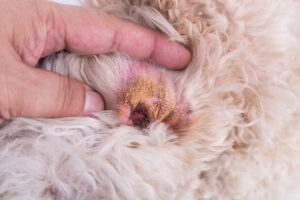
Some hematomas that do not affect the whole earflap may resolve independently without treatment. They may, however, progress to affecting the entire ear. Since treatment success often relies on starting when symptoms first appear, it is always best to have your vet take a look regardless of hematoma size.
Your vet has a few options for treating hematomas. For a burst hematoma, the goal of treatment is to prevent both reoccurrence and infection. A typical appointment may look like this:
- Cleaning the affected area thoroughly. If your dog has long hair, your vet may clip around the ear as well to help prevent contamination.
- Flushing the space to get rid of remaining blood and clots.
- Medications including an oral steroid, pain medication, and antibiotics if needed.
- At this point, your vet will also determine if surgical correction is needed. This involves placing a drain or sutures to help prevent the space from filling with blood again.
It is important to remember that depending on the hematoma’s severity and your dog’s pain level and temperament, your dog may need to be sedated for these procedures. If surgery is required, this will usually involve complete anesthesia.
Popped Dog Ear Hematoma FAQs
Can I Drain My Dog’s Ear Hematoma at Home?
You should not attempt to drain your dog’s ear hematoma on your own – this is for your safety and your dog’s. Your dog can be properly restrained at the vet clinic so nobody gets hurt. Even the best dogs may not feel or act their best when their ear is bothering them.
One of the most important reasons you should not drain the hematoma yourself is that the procedure should be performed in as sterile environment as possible. This means the ear will usually be shaved and scrubbed; the vet will use clean gloves, a sterile needle, and gauze.
Can a Popped Dog Ear Hematoma Heal Itself?
A hematoma that has burst can heal on its own, but it may take longer than if treated. Often the hematoma will refill with blood. The body will eventually reabsorb all the blood and fluids in the ear, but it may heal with scar tissue called a cauliflower ear.
How Long Does It Take for a Popped Dog Ear Hematoma to Heal?
If the hematoma is being treated with medications like steroids, it may heal in a few weeks. Some hematomas have to be drained and treated multiple times though, especially those not undergoing surgery.
If the hematoma is not being treated and has popped on its own, it can take a long time to heal. The blood may reabsorb and then refill in the earflap over the next few months.
Should I Wrap My Dog’s Popped Ear Hematoma?
If the hematoma has just popped, you can apply a soft bandage around the head, keeping the affected ear close to the head. This helps prevent the space in the flap from refilling as quickly.
You should always have a veterinarian show you how to appropriately bandage the ear to ensure it isn’t too tight. Changing the bandage as soon as it gets wet or is soaked is also essential. This helps decrease the risk of infection.
One option to discuss with your vet is the No Flap Ear Wrap, a great alternative to a bandage. It is a specially made cloth bandage that helps keep the affected ear tight against the head.
Can I Give My Dog Benadryl for a Popped Ear Hematoma?
Benadryl is an antihistamine, meaning it is excellent for helping control allergies. It has no antibacterial or pain control properties, so it will not affect an ear hematoma. It is best to consult with your veterinarian before giving any medications or supplements, even over-the-counter medications.
Related posts about ear hematomas
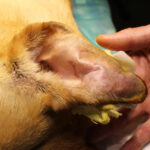 7 Pictures of Ear Hematomas in Dogs [Visual Guide] - You might have noticed that your dog's ear feels puffy and filled with fluid, unlike the soft and smooth ear… [...]
7 Pictures of Ear Hematomas in Dogs [Visual Guide] - You might have noticed that your dog's ear feels puffy and filled with fluid, unlike the soft and smooth ear… [...]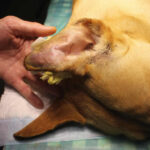 Cauliflower Ear in Dogs: What is It & How to Help Your Dog - Cauliflower Ear in Dogs is a common condition that can affect many breeds and results in great discomfort for your… [...]
Cauliflower Ear in Dogs: What is It & How to Help Your Dog - Cauliflower Ear in Dogs is a common condition that can affect many breeds and results in great discomfort for your… [...]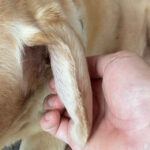 Home Remedies to Help Dogs with Ear Hematomas, by Dr Guise - You’ve found a crazy-looking lump on your dog’s ear and are wondering what you can do to help your poor… [...]
Home Remedies to Help Dogs with Ear Hematomas, by Dr Guise - You’ve found a crazy-looking lump on your dog’s ear and are wondering what you can do to help your poor… [...] Dog Ear Hematomas: A Dog Owner’s Guide - It can be alarming to rub your dog’s ear and feel a puffy, fluid-filled ear that once was soft and… [...]
Dog Ear Hematomas: A Dog Owner’s Guide - It can be alarming to rub your dog’s ear and feel a puffy, fluid-filled ear that once was soft and… [...]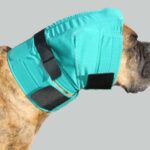 Dog Ear Hematoma Wraps: A Dog Owner’s Guide - Image credit: No Flap Ear Wrap Manufacturer. Overnight your dog’s ear ballooned up into a hot, squishy mess known as… [...]
Dog Ear Hematoma Wraps: A Dog Owner’s Guide - Image credit: No Flap Ear Wrap Manufacturer. Overnight your dog’s ear ballooned up into a hot, squishy mess known as… [...]Disclaimer: This website's content is not a substitute for veterinary care. Always consult with your veterinarian for healthcare decisions. Read More.


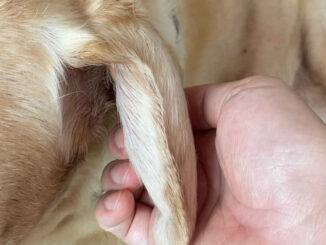
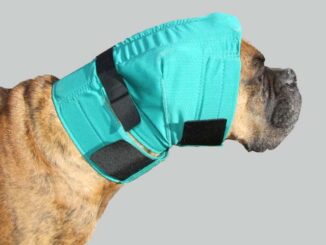
Be the first to comment